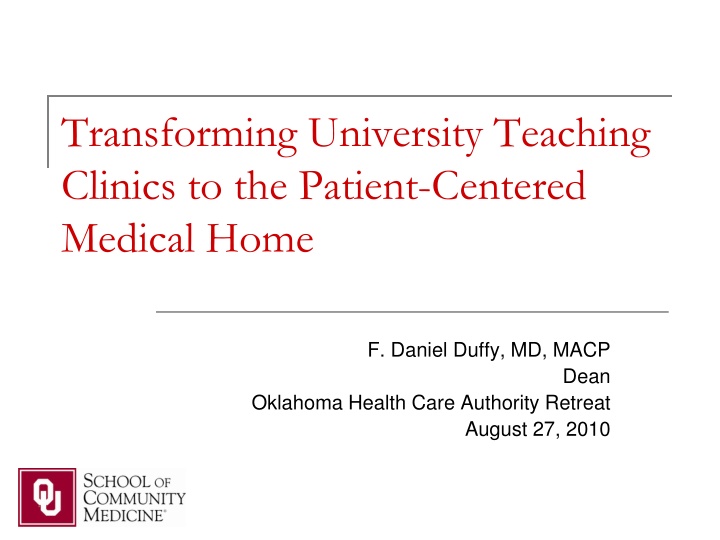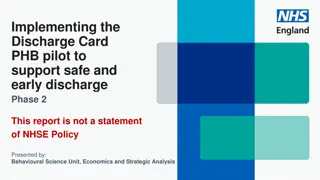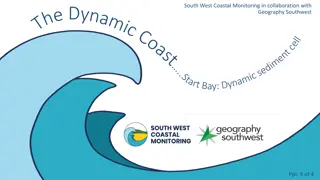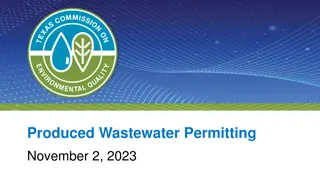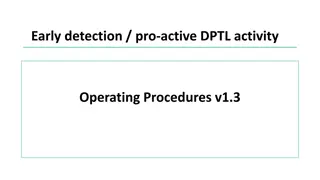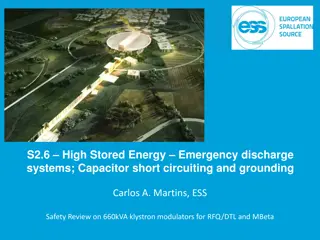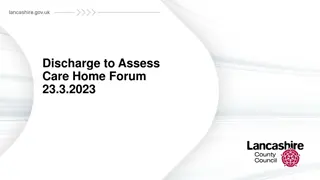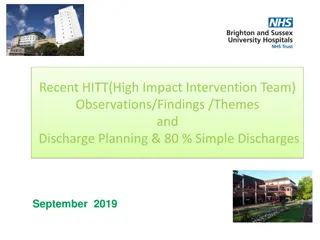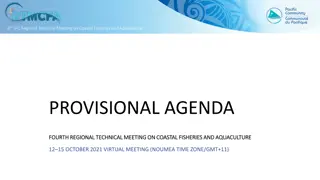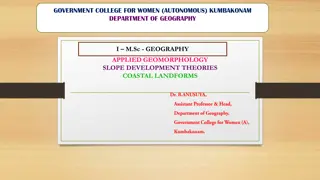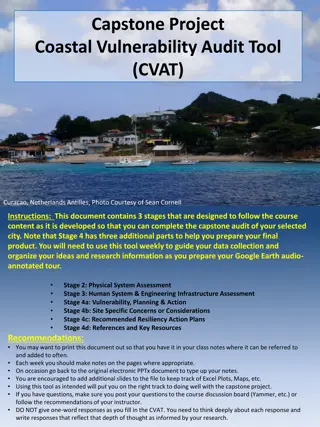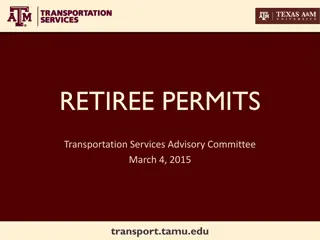Keeping Discharge Prohibition in Coastal Permits
Regional Board Staff emphasize the importance of a discharge prohibition to avoid environmental harm and ensure mitigation in California's coastal projects. The cautionary tale of Carlsbad's MLMP highlights the consequences of lacking firm mitigation requirements. Former Board Member William Von Blasingame stresses the necessity of maintaining discharge prohibitions in permits to protect marine life and ecosystems. Strong regulatory measures are crucial for environmental preservation and responsible development practices.
Uploaded on Mar 17, 2025 | 1 Views
Download Presentation

Please find below an Image/Link to download the presentation.
The content on the website is provided AS IS for your information and personal use only. It may not be sold, licensed, or shared on other websites without obtaining consent from the author.If you encounter any issues during the download, it is possible that the publisher has removed the file from their server.
You are allowed to download the files provided on this website for personal or commercial use, subject to the condition that they are used lawfully. All files are the property of their respective owners.
The content on the website is provided AS IS for your information and personal use only. It may not be sold, licensed, or shared on other websites without obtaining consent from the author.
E N D
Presentation Transcript
Transforming University Teaching Clinics to the Patient-Centered Medical Home F. Daniel Duffy, MD, MACP Dean Oklahoma Health Care Authority Retreat August 27, 2010
Plan for Presentation Patient Centered Medical Home OU School of Community Medicine Vision Practice Transformation Lessons Learned
Oklahoma is the only state where the death rate has gotten worse .. 1,050 Some Factors Economic downturn people and jobs left Oklahoma Poverty remained Heart Disease (Diabetes) Cancer Access to Care Obesity 1,000 1. healthy 950 Age-adjusted Death Rates 2. 900 3. Tulsa US 850 4. 5. 800 1980 1985 1990 1995 2000 2005 6. Past 25 Years
Real Health Disparities NORTH TULSA Shorter Life Expectancy 14 Year difference in Life Expectancy Across Tulsa County SOUTH TULSA Longer Life Expectancy
What is the problem? We have high quality doctors and hospitals. an extensive network of safety net clinics an active and engaged philanthropic community But . . . We have a fragmented healthcare system Payment is tied to seeing more patients in person Patients see doctors in separate health systems Safety net clinics are out of main stream
Patient Centered Medical Home the Answer? National Movement in Health Care Reform Melds streams of practice innovation: Primary Care core elements Relationship-centered care principles Information Technology Care Coordination Chronic Care Model Payment Reform for primary care Nutling PA, et al. Initial Lessons From the First National Demonstration Project on Practice Transformation to a Patient-Centered Medical Home ANNALS OF FAMILY MEDICINE; WWW.ANNFAMMED.ORG VOL. 7, NO. 3 MAY/JUNE 2009
The PCMH Movement An engine for reform in health care delivery, reimbursement, and primary care. Demonstration projects in payment reform in numerous states supported by professional organizations, major employers, insurers, Medicare, state governments, not-for-profit foundations, and Medicaid. Nutling PA, et al. Initial Lessons From the First National Demonstration Project on Practice Transformation to a Patient-Centered Medical Home ANNALS OF FAMILY MEDICINE; WWW.ANNFAMMED.ORG VOL. 7, NO. 3 MAY/JUNE 2009
Our Vision A Network of Patient-Centered Medical Homes will improve the health of Tulsans
OHCA lit a burning platform OU Physicians Payer Mix OTHER 3% SELF PAY 7% MEDICARE & SEC 14% COMMERCIAL 22% MEDICAID & SOONER CHOICE 54%
Patient-Centered Medical Home Project 6 months! Transform the OU Physicians Tulsa into the PCMH model of care for teaching, research, and patient care
Patient Centered Medical Home Sounds nice but what is it really? Patient Centered Medical Home Medical Home Patient Centered Care Coordination and Health Information Exchange $ Payment $ $ Model $
PCMH NCQA Elements Physician Leadership & Expertise in Quality Innovation Patient Data Tracking (Registry) Evidence-Based Standardized Care (Clinician Reminders) E-Prescribing Proactive Care Management (Non-Physician Staff) Test Tracking Self-Care Support (Non-Physician Staff) Referral Tracking Access & Continuity of Care (Communication - Appointments) EMR
MEDICAL HOME CARE TODAY S CARE My patients are those who make appointments to see me Our patients are those who are registered in our medical home We systematically assess all our patients health needs to plan care Patients chief complaints or reasons for visit determines care Care is determined by a proactive plan to meet patient needs without visits Care is determined by today s problem and time available today Care varies by scheduled time and memory or skill of the doctor Care is standardized according to evidence-based guidelines Patients are responsible for coordinating their own care A prepared team of professionals coordinates all patients care I know I deliver high quality care because I m well trained We measure our quality and make rapid changes to improve it Acute care is delivered in the next available appointment and walk-ins Acute care is delivered by open access and non-visit contacts We track tests & consultations, and follow-up after ED & hospital It s up to the patient to tell us what happened to them Clinic operations center on meeting the doctor s needs A multidisciplinary team works at the top of our licenses to serve patients
Medical Home Teamwork New roles and responsibilities Everyone functions at the top of their license New teamwork roles for students and residents New work flow Team meetings for planning and improvement Continuous training, learning, and improvement Non-visit touches deliver pro-active, planned, coordinated, and integrated care Data driven work not visit-driven work New Approach to quality and safety Eliminate re-work Eliminate duplicated effort Eliminate work-a-rounds
Connectivity Tools Electronic Medical Record Reminders, work flow integrated plan, available everywhere Patient Portal Call center, electronic web, cell phones, conference calls Service Portal Doctor portal for consultation and referral tracking Lab, X-ray and Prescription Portal Network Data Warehouse (Registry) Care management: prevention & high risk patients Quality measurement and reporting. Payer Portal
MEDICAL HOME CARE OU S TRANSFORMATION Our patients are those who are registered in our medical home Medical Home Member Agreement We systematically assess all our patients health needs to plan care Annual Health Needs Assessment Care is determined by a proactive plan to meet patient needs without visits Registry: Proactive Plan/Reminders Care is standardized according to evidence-based guidelines EMR templates Practice Policies A prepared team of professionals coordinates all patients care Team meetings Role expansion We measure our quality and make rapid changes to improve it Quality reports Lean-six sigma Acute care is delivered by open access and non-visit contacts Today slots In-/Out-bound Phone We track tests & consultations, and follow-up after ED & hospital E-Lab track, Doc2Doc, High Users A multidisciplinary team works at the top of our licenses to serve patients Docs, Nurses, SW, Pharm D
OHCA Specifics Tier 1 PCMH Primary care & Prevention services Immunizations Organized clinical data Medication lists Administration functions for billing Tracks & Follow-up tests/x-rays with patient Tracks referrals until completed PCP continuity & specialist coordination
OHCA Specifics Tier 2 Accepts electronic data from Health Care Authority 24/7 voice contact, triage, on-call professional Extended hours Use PCMH agreement with patients Use OCHA data for proactive planning services Continuity of care for acute visits Behavior health and substance abuse screening Use variety of forms of communication with patients Tracks care received in ER/Hosp/Others use case management registry
OHCA Specifics Tier 3 Health care team led by a primary care physician Medication reconciliation Use health assessment tools to identify patients needs Personalized screening process Evidence based prevention/chronic care guidelines Measure performance & quality improvement action Use Sooner Care management program Trains staff in care management roles Document patient self-care support Available at least 4 after-hours per week Integrated care plan for patient co-management Interactive web-based patient portal
What does Tier 1 need to get to Tier3? Care management support Tools for care coordination Social services Help getting patients into specialty care Practice optimization help EMR implementation help View of big picture Data and analytics
Birth of a Health Access Network Choose 3 organizations in the state to provide extra services to networks of doctors Reduce costs Improve access to specialty services Enhance coordination of care Improve the health status of communities Reduce health disparities in communities Pay the networks an additional fee for all patients in their networks Oklahoma Health Care Authority Logo
The Sooner Health Access Network Care management: working with PCMH s to improve patient health at a population level Secure communication: Between providers and patients Advanced health care analytics: Data to support intelligent care delivery Care coordination: flight control for patients who see multiple doctors and hospitals
Lesions from National PCMH Pilots Becoming a PCMH Requires Transformation Epic whole-practice re-imagination and redesign. Transformation is a Developmental Process Transformation is a Local Process Requires Personal Transformation of Physicians Technology is Not Plug and Play Change Fatigue is a Serious Concern Nutling PA, et al. Initial Lessons From the First National Demonstration Project on Practice Transformation to a Patient-Centered Medical Home ANNALS OF FAMILY MEDICINE; WWW.ANNFAMMED.ORG VOL. 7, NO. 3 MAY/JUNE 2009
Learning Organization Transformation means becoming a learning organization to co-create an emergent future rather than to learn how to build something already known. Learning organizations challenge the conventional expert model that expects consultants to come with external expertise and simply fix problems. Nutling PA, et al. Initial Lessons From the First National Demonstration Project on Practice Transformation to a Patient-Centered Medical Home ANNALS OF FAMILY MEDICINE; WWW.ANNFAMMED.ORG VOL. 7, NO. 3 MAY/JUNE 2009
What have we learned? We can be a learning organization We have not, but can, document our work processes to know what we do Front-line input to clinical and business procedures is essential! Every good idea has unintended consequences Changing work means people changing and using technology
Leadership Keeps Vision Competing leadership signals External priorities Change is human not technological Supporting pain of transformation Appreciation Repeated clear message: We can do this! We must do this! Excitement about the emerging future
